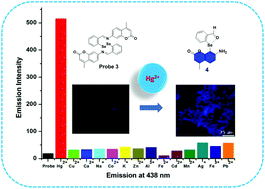An efficient chemodosimeter for the detection of Hg(ii) via diselenide oxidation†
Abstract
Mercury ions are toxic and exhibit hazardous effects on the environment and biological systems, and thus demand for the selective and sensitive detection of mercury has become considerably an important issue. Here, we have developed a diselenide containing coumarin-based probe 3 for the selective detection of Hg(II) with a “turn-on” response (a 48 fold increase in fluorescence intensity) at 438 nm. The probe could quantitatively detect Hg(II) with a detection limit of 1.32 μM in PBS solution. Moreover, the probe has operable efficiency over the physiological range with an increase in the quantum yield from 1.2% to 57.3%. The reaction of the probe with Hg(II) yielded a novel monoselenide based coumarin 4via diselenide oxidation, which was confirmed by single crystal XRD. Furthermore, the biological use of the probe for the detection of Hg(II) was confirmed in the MCF-7 cell line. To the best of our knowledge, this is the first reaction-based probe for Hg(II) via diselenide oxidation.



 Please wait while we load your content...
Please wait while we load your content...